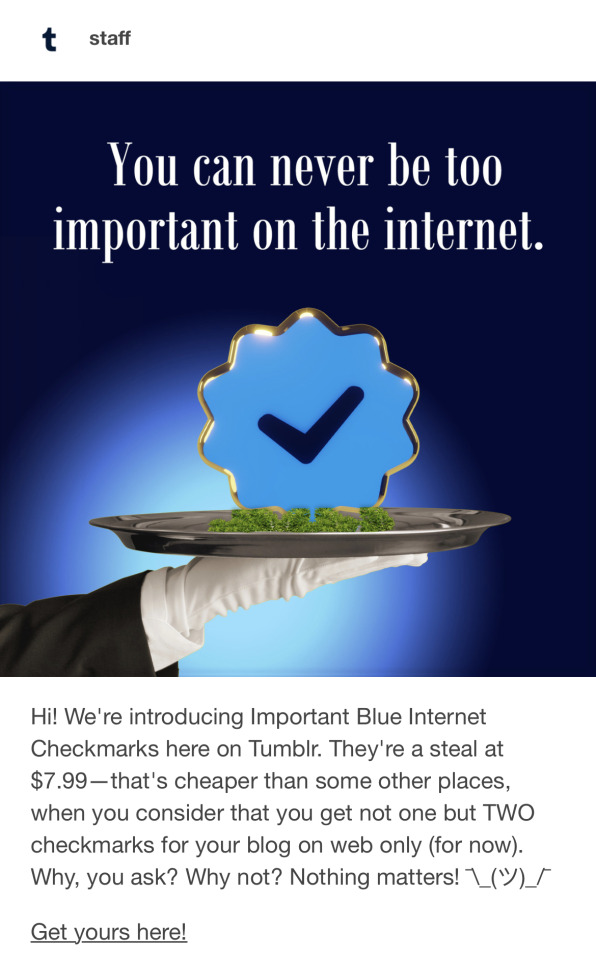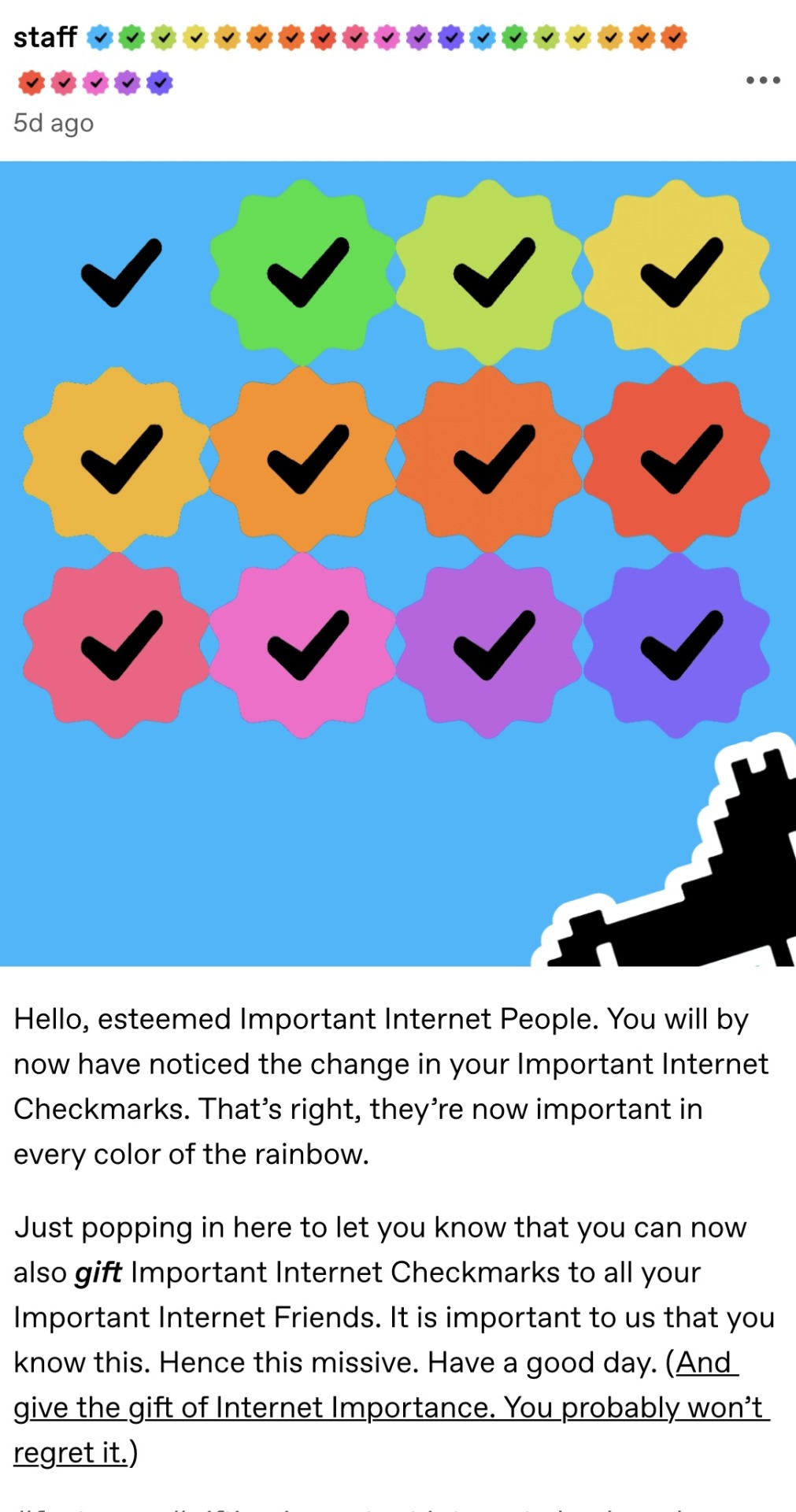#AuliaSays
Explore tagged Tumblr posts
Text
AI voice detection and recognition are becoming more crucial
This Twitter thread shows how far along artificial voices have come. For those who are familiar with Steve Jobs’ voice, the voice in these recordings is almost indistinguishable from the original. When you listen to them, you can be forgiven to think that it’s actually Steve Jobs saying these words, never mind that he’s been gone for more than a decade.
The only catch is that because the training set must have been taken from the many recordings of his Apple keynote speeches and product announcements, they all sound like he’s reading from a script or making announcements. None of the sentences sound natural the way someone would speak if they were having a regular conversation or answering questions but that’s not too difficult to overcome. The tools to make adjustments to AI generated voices to sound more natural already exists.
Here’s another example. The YouTube channel Star Wars Comics have started to experiment with using generated voices to narrate some storyline’s from the Star Wars comic books to keep their audience up to date with what’s happening in the comics. In one video, they used James Earl Jones’ Darth Vader voice to say the lines in the pages of the comic book. Their latest video voiced a conversation between Emperor Palpatine and Darth Vader from another issue in the recent Darth Vader comic book series, both using the generated voices of their real actors.
As many in the comments noted, while their voices sound indistinguishable from the original, the speech patterns make it obvious that these were generated. That’s because the voices weren’t adjusted to the way a person would speak in a proper conversation given in the situation. Again, these are relatively trivial changes that one could make using their AI voice generators.
While these may be little more than fun projects for the curious minds, the day when someone can create entirely fabricated recordings to manipulate the public is already here. You can already create fake videos of a person saying things that they never actually said, now the voices sound even closer to the original.
When deepfake videos started popping up in 2020, people knew that this was going to be a significant problem. People are already easily fooled by fabricated articles or stories and this is just going to make it far more challenging for people to fact check and verify the validity of recordings.
All I can say for that is, brace for impact.
9 notes
·
View notes
Text

Of course he is guilty of the very thing he accused someone of
He lied about the death of his son for clout and got called out by his ex on his own social network. Does that mean he has no mercy for himself?
7 notes
·
View notes
Text
Movie studios could be liable for releasing misleading trailers
Two Ana de Armas fans successfully sued Universal for not featuring the actress in the movie Yesterday despite being part of the trailers, after they rented the movie to watch at home.
This is dangerous territory. Trailers come out months before the final cut of the movie gets approved and often there are rewrites and reshoots.
The judge said the ruling is limited to whether an actor or actress and scenes are in the movie. Teasers and trailers are made and released based on what’s available to the trailer editors at the time which does not include decisions to alter the movie down the line.
One of the most obvious examples is Rogue One which had an extensive third act rewrite and therefore reshoots after several trailers were released. Tony Gilroy, who took over from Gareth Edwards, made substantial changes to the movie that several footage from the trailers didn’t make it to the movie. Promoted scenes were dropped.
The American legal scene is crazy enough that based on this ruling someone can sue Disney for not including the train station scene from the trailer in the movie.
If a trailer is actually deceptively released, with a “malicious” intent of lying to the audience about aspects of the movie, sure, you can claim false advertising but you have to prove intent.
I feel like we’re going to hear much more about this sooner than later. Like how Universal’s undoubtedly expensive lawyers failed to make convincing arguments.
If you’re going to watch a movie at home, especially one that supposedly features your favorite actress, I feel like you should have the time to at least look it up on IMDb or read reviews. The movie had been out for months, reviews had been published, and her being dropped from the movie was widely known by the time it made the home release. Ignorance shouldn’t be a reason for winning lawsuits.
Unless this ruling gets thrown out on appeal, it could change how studios promote movies. Trailers would have to be crafted around potential lawsuits from late changes to the movie.
1 note
·
View note
Text
San Francisco’s robot dogs won’t be equipped with guns after all. They may have explosives instead
The other day we saw news reports of San Francisco police being given authorization to deploy killer robot dogs. The city’s board of supervisors voted 8-3 in favor of the motion despite heated debates about safety and potential abuse.
The police denied claims that they will arm their robot dogs with guns but according to AP, they could be armed with explosives. How is that any better?
the department could deploy robots equipped with explosive charges “to contact, incapacitate, or disorient violent, armed, or dangerous suspect” when lives are at stake, SFPD spokesperson Allison Maxie said in a statement.
At least they said the use will be limited to extreme situations and require authorization from high ranking officers. We know how restraint police officers of all ranks can be in the United States, don’t we?
Supervisors amended the proposal Tuesday to specify that officers could use robots only after using alternative force or de-escalation tactics, or concluding they would not be able to subdue the suspect through those alternative means. Only a limited number of high-ranking officers could authorize use of robots as a deadly force option.
San Francisco’s authorities can’t seem to restrain themselves from being swept along by the American trend of increased militarization of their law enforcement forces. From military grade weapons, armor, vehicles, and now exploding robot dogs.
Meanwhile across the bay in Oakland, the city’s police department backed down from a similar proposal after a massive public backlash.
That Black Mirror episode, Metalhead, from season 4, immediately comes to mind.
1 note
·
View note
Text
Verifying Identity on Mastodon
Here’s a thread on Mastodon about the debate over the use of third party verification services.
The fediverse is what they call the federated universe, the part of the Internet that’s run by multiple individuals across multiple independent servers but interconnected as a larger network. A network whose existence is not dependent on a single corporation.
Anyway, here it is. Tap on “show more” to read the posts.
1 note
·
View note
Text
Meta follows Twitter in charging for the coveted blue internet checkmark
Weeks after someone saw code inside the Instagram app referring to paid verification, Meta today formally announced their latest copycat feature, the paid blue checkmark.
Like pretty much every major product that Meta offers, the blue checkmark originally came from somewhere else, in this case, Twitter. Now that Twitter is charging for it, Meta can’t resist doing the same but they added their own twist.
Just like Twitter’s version, you’ll get the all important blue badge, increased visibility and reach, and exclusive features, but you’ll also get personal customer support, something that Twitter can’t offer because Elon fired everyone already.
Meta’s checkmarks are more expensive than Twitter’s. Even more expensive than paying for Netflix, Disney+, or HBO GO. One month of Meta Verification costs the same as Disney+ Hotstar for one entire year. Think about that.
Twitter charges US$11 per month from mobile apps and $8 from the web, while Meta charges $15 from mobile apps and $11 from the web.
Meta’s paid checkmarks are available only in Australia and New Zealand for now, though, so they make you crave for it with the oh so good FOMO and envy brewing up inside of you.
But my favorite one, though, is Tumblr. For a one time payment of $8 you get not one but two badges all at once and if that’s not enough, you can buy and display up to 12 pairs of badges! They now come in all rainbow colors too, not just blue, so it’s so much fancier and cooler because you can pick and choose which colors you want. You pay once and you keep it forever. Or until you delete your account. Love those guys.




0 notes
Text
Just spent half the day helping my kid format her school paper on Word. I haven’t touched that software probably in more than a decade. Always worked on alternative apps like Pages, Notes, TextEdit, Docs, Bear, iA Writer, etc.
Talk about being overwhelmed. Had to hunt and peck each button and feature and search online for tips on how to do certain things.
Never got my parents to help me with any of those as a kid because they didn’t grow up or worked with computers and to this day they still don’t know how to operate one beyond using browsers and WhatsApp. Had to figure things out myself and it was practically troubleshooting which got me into tech support before journalism kicked in.
As someone who lived through his entire life surrounded by tech products and devices and worked as tech support for a significant period, this was kind of embarrassing but also challenging and humbling. It took much longer to complete than it ought to but got it done eventually.
Getting the brain to reconnect neurons that didn’t need to connect for a long time was quite an exercise. Pretty exciting, actually, but also exhausting.
0 notes
Text
Blogs vs Microblogs
I’ve shared my thoughts about microblogs vs proper blogs a few times over the years but even after more than 20 years of blogging and more than 15 years of microblogging I still haven’t landed on a definitive position.
It’s evident that the era of Twitter has rendered blogs almost exclusively for more niche segments. The ability of microblogs to deliver almost instant readership and feedback to a piece of writing gives their authors relentless dopamine shots that keeps them around for much longer periods.
Blogs allow for more verbose and nuanced posts but when microblogs allow for that to happen as well, that makes you question the necessity of blogs other than the more obvious ones such as easier indexing, categorization, search, and discovery.
I guess it’s a matter of choosing between delivering more complete thoughts on a faster conversational platform and putting them down on your own space that you can have better control over.
Sometimes I wonder what would happen had something like Pownce had prevailed instead but that would require an alternate world in which the public chose Gowalla over Foursquare. Simplicity seems more likely to win over more complete or elaborate executions in our world after all.
0 notes
Text

The NY Times changed the headline of Jamelle Bouie’s opinion piece to be much less direct.
I haven’t been a Times subscriber in years and haven’t read anything from there for a while. The more I see this sort of behavior from their editorial team the more I’m convinced the Times is not worth the attention it’s getting. By no means it can be referred to as the paper of record.
The NY Times is a lot like Twitter. It’s an ongoing and escalating dumpster fire but it has so many eyeballs and attention people keep publishing and reading stuff there and triggering more complaints about them.
I get that the second headline is more clickbaity to draw in more curious readers (and page views) because the first headline will definitely be rejected by those who aren’t interested in the issue or will reject anything defending trans rights, but when you read Parker Molloy’s piece, it tells you that the headline change is much deeper than that. It’s more plausible that it’s a deliberate act against the trans community even if they try to argue it’s not the intention.
The NY Times have responded to the claims of being anti trans with a statement published by Nieman Lab. If ever there was a statement that nobody but the writer believes in it, this would be it.
0 notes
Text
Who wants to pay for a checkmark?
Hey, look who’s taking after one of the most unhinged individuals to ever run a company and dipping their toes into making identity verification a commercial product?
The entire point of account verification is all about confirming that the profile account represents who it claims to be. The part about having to be a notable person or organization was a side effect of the notion that only public figures needed to have their account verified to avoid impersonation.
The fact is anyone or any organization could be impersonated for any reason as notability needs not be on a national, let alone global, level.
If Meta is truly aiming to drive revenue out of account verification then it’s not about notability anymore. They should just make it like Tumblr and charge it for kicks because nobody knows if you’re a dog, who cares as long as you pay? The initial roll out of the revamped Twitter Blue went exactly as everyone outside of the company would expecte.
If account verification is about identity they can do it by enabling rel=“me” by way of a website that the person or entity controls.
The rel="me" identity verification attribute is used to establish a link between a website and a person’s or organization’s profile on another site. This will assert that the entity owns or runs both the website and the profile on the other site.
Basically it lets other websites or services know that you are who you say you are without having to submit further proof of identity such as your government ID and saves them from the arduous process of manually verifying every profile created on their service and saves you from the repetitive process at each online service.
However, because there’s no central authority that actually verifies this attribution it can create a single point of failure if the reference website gets hijacked, leading to security issues such as identity fraud.
Between the lack of central authority and chaos through impersonation accounts, essentially it comes down to which problem they are more willing to deal with. And if say it costs $5 a month to have a check mark next to your name, that’s potentially hundreds millions maybe billions of dollars of additional annual revenue. Who’s gonna say no to that?
Before you know it every corporate social network will charge for a check mark and you’ll be spending more per month than your streaming subscriptions combined.
0 notes
Text
Twitter ends all free public API, switches to paid access
“Putting a cap on free API usage could also stop firms working around detecting the spread of misinformation on Twitter.”
That right there is the money shot. Misinformation is much more freely distributed today on the platform than at any time last year without the full trust and safety team and council working to suppress them. Then again the definition of what constitutes misinformation seems to have changed within the company.
The other point is why would any self respecting developer jump right back in after being suddenly shut out without prior or even any official communication on the sudden change of policy?
Anybody who still trusts the company to do anything right must be kidding themselves.
If anything, third party developers might be even more inclined now, if not highly encouraged, to develop for other platforms that offer free or open source API *cough*Mastodon*cough*.
Mastodon isn’t the only open platform in play that takes advantage of the ActivityPub protocol. There are plenty others such as Friendica, Pleroma, CalcKey, etc., that connect through this protocol, which means the playground for software developers and designers is wide open. Even WordPress, Tumblr, and Flickr have ActivityPub on the roadmap for this year.
There’s far more interest now on the federated networks or the open social web than ever before and networks that stay closed are going to miss out.
0 notes
Text

Instagram founders Kevin Systrom and Mike Krieger have reteamed to launch Artifact, an AI driven personalized news feed that also lets you and your friends discuss about each story you share.
Casey Newton, who broke the news, calls it TikTok for text. From his description it sounds like AI driven Flipboard with chat.
As you can see from the screenshot registration is limited to US phone numbers for the time being. They’re clearly in testing mode and managing traffic. The whitelist, iPhone exclusive period, and pretty interface create a FOMO mindset among those who can’t get in yet.
It’s the stereotypical Silicon Valley product launch. Create a pretty app and generate widespread hype and FOMO by limiting access and riding on the news wave and public chatter.
From John Gruber’s take it’s not a promising start, maybe it’s far too early to judge. Right now it’s closer to a newsreader than a social app of any kind, and maybe that is the whole point and the conversation aspect is just a minor feature.
0 notes
Text
One Fediverse app to rule them all?
A few days ago I said, “should one build an all encompassing Activity Pub app? I don’t think so because it would end up as a big confusing hot mess. Apps optimized for individual services are still the way to go in my opinion.”
This was in reference to the different platforms like Friendica, micro.blog, and Pixelfed. I don’t think one app should be able to cover all of the platforms because it would be a terrible app – jack of all trades master of none, thing.
However, having used Akkoma, Takahe, and Misskey, it seems that while there are platforms that serve different purposes and functions, a lot of the fediverse platforms can be considered different versions of the same thing.
Like Twitter, Pownce, Jaiku, and BrightKite (OMG, anyone remember BrightKite?), they all were meant to have the same core function but grew differently with different features because the founders each had different priorities and what they considered important. Twitter was probably the most basic of them all.
For all the platforms that share a large overlap like Mastodon, Pleroma, Akkoma, MissKey, CalcKey, etc., it might make sense for a single app like Ivory, Mammoth, or Ice Cubes, to accommodate them all or for the platforms to implement more shared API and increase interoperability. This should allow people who are on the overlapping platforms to use the same app and increase the market for the app.
Not sure about the technical requirements to have all the similar platforms be much more interoperable but it looks like it’s entirely possible.
0 notes
Text
The things online stores do
I bought two boxes of masks that were supposed to be delivered yesterday. They didn’t arrive.
When I remembered this afternoon to check for the masks, my brother told me there was a package earlier on the bookshelf. It was a sealed black plastic bag. Ok, not boxes, which means I needed to check the app and see where my order was because the package felt like they could be clothes inside, not boxes of masks. When I checked the app it said they’ve been delivered. But there were no boxes delivered today, just the one plastic bag.
So I went to open the bag. And as I was opening it, I wondered if they took out the masks and repacked them without the boxes. I mean, okay, maybe they’re being sus about it or just didn’t want to send the boxes to make it a smaller package and save money.
I poured the contents out and sure enough, four small plastic bags full of masks. Suspicions almost confirmed. Right?
Wrong.
Inside the bag there were the two boxes the masks were supposed to be inside of. But they were flattened. THEY WERE FLATTENED!!! These two boxes were looking freshly flat as if they just came out of the goddamn box production line!
Geniuses, fucking geniuses, these people. Save money on the delivery and making them easier to transport by unboxing the masks and flattening the boxes.
Props to the sellers, man.


0 notes
Text



Speaking of third party Mastodon clients…
Checking out phanpy.social, it looks amazing. So clean, very app like, adjustable text size and interface via browser control. It’s still in development but it looks like it’s ready for regular use if you’re looking for a visually pleasing and functional web app for Mastodon. Best used on mobile or tablet, IMO.
All the boosted posts are grouped together in a carousel, threads get highlighted with an automated count, replies have a different shade, content warning, post visibility, text description, language options, attachments, and polls are available.
Posts are shown either as the normal stack of text blocks or separated as cards depending on your browser’s zoom level, and you can launch the post composition field into a different browser window for much larger and clearer view.
It has dark mode and post detail opens up in a new sheet over the timeline in the same window. Love it!
PS: Here’s an actively updated list of clients and resources for Mastodon
0 notes
Text
A Twitterrific for Mastodon?
I’m heartbroken that Twitterrific had to die and I don’t suppose Iconfactory plans to build a Mastodon app. Twitterrific developer Craig Hockenberry mentioned in his blog post that the new Mastodon apps are excellent to help with the transition but they ignore the scale and possibilities of ActivityPub.
I can understand that. I mean, Mastodon is clearly the flagship ActivityPub client right now but its nature means you can see status updates or posts from people posting using other environments such as Pleroma, Misskey, CalcKey, Friendica, Pixelfed, PeerTube, Takahe, micro.blog, etc which are not Mastodon and not fully compatible with the Mastodon API, but they kind of work similarly in some ways yet at the same time quite differently as well.
Should one build an all encompassing Activity Pub app? I don’t think so because it would end up as a big confusing hot mess. Apps optimized for individual services are still the way to go in my opinion. I’m still hopeful that there’s an Iconfactory take that can accommodate the Fediverse because the team has always managed to come up with innovative designs and user experience. They’ve never been afraid of experimenting with different approaches to the same problem.
Maybe they have something in mind already or secretly have been building something, maybe they haven’t. Given the response they gave to being abruptly shut out of Twitter, maybe they’re going to take some time before deciding on their next step.
Right now there’s already plenty of upcoming third party Mastodon apps to choose from for iOS even if they’re still in TestFlight, not to mention existing ones as well as web apps that can work across platforms, but a buffet of choices never stopped new ones from appearing.
0 notes